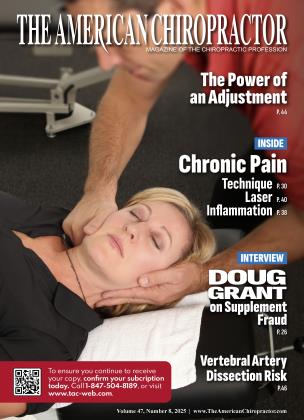
CAN NUTRITION SUPPLEMENTS significantly add to Health Span and to Life Span? We can state unequivocally, after more than 40 years applying metabolic biochemistry to increase patients’ adaptative capacity, the answer is, quite sadly, “No.” Why not?
Clinical Nutrition has never risen above the level of peddling health food industry remedies. “Take this supplement for that symptom.” “That supplement is good for this condition.” Alternative healthcare providers are dispensing evermore sophisticated (if that is the right word) supplements, but essentially they are trapped in the allopathic paradigm. They are treating symptoms with the currently popular “natural” cures as an “alternative” to addressing ailments pharmacologically — at best, a more benign form of ignorance.
You and your patients need a true alternative. Research over the past two decades shows that the broad array of symptoms your patients present are all driven by a very few metabolic imbalances. These patho-physiologies all involve inflammation, and they are all signs indicating “Diseases of Aging,” even when manifest in young patients. The science of Gerontology convincingly shows these “Inflam-Aging” processes can be controlled with very specific combinations of nutrients — particularly those classified as Adaptogens and Rejuvenins.
Essentially we are asking, would you rather treat the disease, or treat the patient? Would you rather address the symptoms as they manifest, or reach deeply into the core of the patho-physiology?
Consider this list:
• Musculoskeletal Inflammation
• Chronic Fatigue
• Elevated Cholesterol and Triglycerides
• Type II Diabetes
• Arteriosclerosis
• High Blood Pressure
• Neurodegenerative Diseases
• Autoimmune Diseases
• Neuropathy
• Muscular Weakness
• Osteoporosis
• Cataracts
You easily recognize these conditions that you see in your patients on a daily basis. Are you desperately seeking a “remedy” for each item on the list? Or, does it make more sense to treat the underlying causes? Why pursue a frustrating, tedious, and expensive exercise in futility? For any of the above patho-physiologies, you can sell your patients the “Flavor of the Month” supplement. But why deal with repeated disappointment when the research literature shows clearly that you have the capability to address each pathological process at the cellular level?
For years, Gerontology research pursued its elusive quest for the ultimate — a Universal Theory of Aging. The scientific breakthrough occurred a couple decades ago with the understanding that all the Age-Related Diseases have an inflammatory component. Gerontologists latched onto this central truth, finally discovering how this concept of inflammation manifests in the “diseases of aging.”
Furthermore, Gerontology identified two somewhat autonomous aging pathways, each inflammatory in nature, but inflammatory by different mechanisms. The term “Inflam-aging” began to appear in the research literature.14
The good news for you as a clinician is that the many and varied manifestations of Age-Related Diseases are the product of nothing more than these two aging pathways. The twelve patho-physiologies listed above are as different as can be, yet they all share just two fundamental age-accelerating processes. Consider two of your patients, one with a painful unstable knee, and one with elevated cholesterol. Who would think there is a connection between those two conditions? Yet, Gerontologists now show us that the same two fundamental aging pathways drive both conditions 2,6,10,12-18
Though Age-Related Diseases may not fully manifest until we reach the age of 50 or more (although it is increasingly common to see the tell-tale signs in people in their 30s), their pathogenic basis has its roots much earlier in life — even in childhood. Why does one patient show inflam-aging in his knee, whereas another cannot seem to get her cholesterol under control? The concept here is easy to grasp. “Every chain breaks at its weakest link.” Whatever genetic predispositions an individual may have, plus whatever environmental stresses were encountered early in life, predispose to metabolic imbalances and their resultant deficiencies in adaptive capacity.5-8'10,14,17,19
Of course, we must give you objective proof that your having the capacity to reverse the aging process with metabolic therapy (rather than clinical nutrition) is not an outlandish claim.
Consider just one study that supplemented older adults with only 2 of the supplements Gerontologists call “Rejuvenins” 20-22
At baseline, older adults (OA), with an average age of approximately 71, were compared to younger adults (YA), with an average age of approximately 26. Imagine these rejuvenating benefits to OA after only 16 weeks:
• 71-year-olds at baseline had extreme elevations of age-accelerating inflammatory cytokines compared to 26-year-olds: Interleukin-6 820% higher; Tumor Necrosis Factor-alpha 290% higher; and C-Reactive Protein 100% higher; along with a lower level of the anti-inflammatory cytokine Interleukin-10. After 16 weeks of supplementing with just 2 Rejuvenins, IL-6 was lowered by 78%, TNF-a by 54%, and CRP by 41% as IL-10 increased by 94%. Those are the astounding facts -quantified and irrefutable.
• OA had 66% lower muscle Glutathione, which increased 164% to the same level as YA.
• Markers of oxidative damage were 424% higher in OA, yet decreased all the way down to the level of YA.
• In physical function tests, OA were extremely deficient relative to YA in gait speed, grip strength, chair-rise test, and 6-minute rapid walk test. The 6-minute rapid walk test showed significant improvement from supplementation, and every one of the other tests was brought up to the performance level of YA.
• OA, as compared to YA, had significantly higher body weight, BMI, fat mass, and waist circumference. All those parameters improved, with a particularly significant improvement in waist circumference, achieved with no attempt at weight loss.
• Rejuvenin supplementation significantly lowered systolic blood pressure in OA.
• Mitochondrial energy production was evaluated using muscle fatty acid oxidation as a marker. OA were 42% lower in mitochondrial function than YA, yet muscle fatty acid oxidation improved by 78% to the same mitochondrial efficiency as YA.
“Every chain breaks at its weakest link.”
• OA showed poor glycemic control, with significantly higher insulin resistance and fasting plasma insulin, which supplementation decreased by 64% and 65%, respectively, to the same level as YA. In the process, supplementation significantly increased Muscle Glucose Transporter-4 and Sirtuin expression.
• DNA damage was elevated to an extreme in OA, yet was decreased by 73%. Both mitophagy and autophagy (critical youth-preserving processes) were improved.
• Measures of stem-cell exhaustion, cellular senescence, and telomere health were vastly improved by 16 weeks of supplementation.
• Two markers of endothelial function, and thus the tendency toward atherosclerosis, were elevated by 271% and 124%, in OA at baseline, and they were decreased to the same level as YA. The triglyceride level was decreased by 16%.
You need to ask yourself, “Do the supplements I recommend have the power to decrease the inflammatory state (INFLAM-AGING) of my 71-year-old patients to the level of a healthy 26-yearold? Do my supplements stoke the fire of their mitochondria to maximize the burn of fat and carbs to match the energetics of a young adult? Are my recommendatiwons restoring grip strength and muscular stamina even without the benefit of an exercise regimen?” It may be time to redefine yourself, no longer as a Clinical Nutritionist, but as a Metabolic Therapist.14

Dr. Guy Schenker, a Pennsylvania Chiropractor since 1978, developed the Nutri-Spec System of Clinical Nutrition, which eschews symptom-based nutrition in favor of individualized metabolic therapy. Reach us at 800-736-4320, email [email protected], or visit Nutri-Spec.net.
1. Baek SH, et al. Modulation of mitochondrial function and autophagy mediates camosine neuroprotection against ischemic brain damage. Stroke. 2014;45(8):2438-2443. https://pubmed.ncbi.nlm.nih.go...
2. Blagosklonny MV. Prospective treatment of age-related diseases by slowing down aging. Am J Pathol. 2012;181:1142-1146. https://pubmed. ncbi.nlm.nih.gov/22841821/
3. Blagosklonny M.V. The goal of geroscience is life extension. Onotoarget. 2017:8:35492. https://pubmed.ncbi.nlm.nih.go...
4. Ho Jen-Yu, et al. L-carnitine supplementation favorably affects biochemical markers of recovery from physical exertion in middle-aged men and women. Metabolism. 2010 Aug;59(8): 1190-9. https://pubmed.ncbi. nlm.nih.gov/20045157/
5. Justice JN, et al. A framework for selection of blood-based biomarkers for geroscience-guided clinical trials: Report from the TAME biomarkers workgroup. Geroscience. 2018;40:419-436. https://pubmed.ncbi.nlm.nih. gov/30151729/
6. Le Couteur DG, Barzilai N. New horizons in life extension, healthspan extension and exceptional longevity. Age Ageing. 2022;51(8):156. https:// pubmed .ncbi .nlm .nih .gov/3 5932241/
7. McCarty MF. Practical prospects for boosting hepatic production of the “pro-longevity'’ hormone FGF 21. Hormone Molecular Biology and Clinical Investigation. 2015;30(2). https://pubmed.ncbi.nlm.nih.go...
8. Poljsak B, et al. Healthy lifestyle recommendations: Do the beneficial effects originate from NAD(+) amount at the cellular level? Oxid Med Cell Longev. 2020 Decl2;2020:8819627. https://pubmed.ncbi.nlm.nih. gov/33414897/
9. Sekhar, RV. GlyNAC supplementation improves glutathione deficiency, oxidative stress, mitochondrial dysfunction, inflammation, aging hallmarks, metabolic defects, muscle strength, cognitive decline and body composition: Implication for healthy aging.JNutr. 2021 Dec3;151(12):3606-3616. https: //pubmed .ncbi .nlm .nih .gov/345 87244/
10. Sekhar RV. Glycine and N-acetylcysteine (GlyNAC) supplementation improves impaired mitochondrial fuel oxidation and lowers insulin resistance in patients with type 2 diabetes: Results of a pilot study. Antioxidants (Basel). 2022 Janl3;ll(l):154. https://pubmed.ncbi.nlm.nih. gov/35052658/
11. Tallon MJ, et al. Camosine, taurine and enzyme activities of human skeletal muscle fibers from elderly subjects with osteoarthritis and young moderately active subjects. Bio Gerontology. 2007;8(2): 129-137. https:// pubmed.ncbi.nlm.nih.gov/16967207/
12. Chen TH, et al. Probiotic supplementation attenuates age-related sarcopenia via the gut-muscle axis in SAMP8MICE. J. Cachexia Sarcopenia Muscle. 2022 Feb: 13(1):515-531. https://pubmed.ncbi.nlm.nih. gov/34766473/
13. Tabibzadeh S. From genoprotection to rejuvenation. Front Biosci. 2021;26:97-162. https://pubmed.ncbi.nlm.nih.go...
14. Fulop T, et al. Immunology of Aging: The Birth of Inflam-aging. Clin Rev Allergy Immunol. 2023. Apr;64(2): 109-122. https://pubmed.ncbi. nlm .nih.gov/345 36213/
15. Hickson LJ, et al. Senolytics decrease senescent cells in humans: Preliminary report from a clinical trial of dasatinib plus quercetin in individuals with diabetic kidney disease. E Bio Medicine. 2019;47:446-456. https: //pubmed .ncbi .nlm .nih .gov/31542391/
16. Levine DC, et al. NAD+ controls circadian reprogramming through PER2 nuclear translocation to counter aging. Mol Cell. 2020;78(5):835849. https://pubmed.ncbi.nlm.nih.go...
17. G Wick, et al. Diseases of aging. Vaccine. 2000 Feb25;18(16);156783 .https://www.sciencedirect.com/... S0264410X99004892
18. Wu T, et al. The effect of L-carnosine on the circadian resetting of clock genes in the heart of rats. Mol Biol Rep. 2015;42(l):87-94. https:// pubmed .ncbi .nlm .nih .gov/2525 8119/
19. Tabibzadeh S. From genoprotection to rejuvenation. Front Biosci. 2021;26:97-162. https://pubmed.ncbi.nlm.nih.go...
20. Kumar, P. Glycine and N-Acetyl-Cysteine supplementation in older adults improves Glutathione Deficiency, Oxidative Stress, Mitochondrial dysfunction, inflammation, insulin resistance, endothelial dysfunction, genotoxicity, muscle strength and cognition: Results of a pilot clinical trial. Clin TranslMed. 11 (3), e 372. https://pubmed.ncbi.nlm.nih.go...
21. Sekhar, RV. GlyNAC Supplementation improves Glutathione deficiency, oxidative stress, mitochondrial dysfunction, inflammation, aging hallmarks, metabolic defects, muscle strength, cognitive decline and body composition: implication for healthy aging. J Nutr. 2021 Dec 3; 15l(12):3606-3616. https://pubmed.ncbi.nlm.nih.go...
22. Sekhar RV. GlyNAC (Glycine and N-Acetylcysteine) supplementation improves impaired mitochondrial fuel oxidation and lowers insulin resistance in patients with Type 2 diabetes: results of a pilot study. Antioxidants (Basel). 2022 Jan 13;11(1):154. https://pubmed.ncbi.nlm.nih. gov/35052658/
 View Full Issue
View Full Issue






